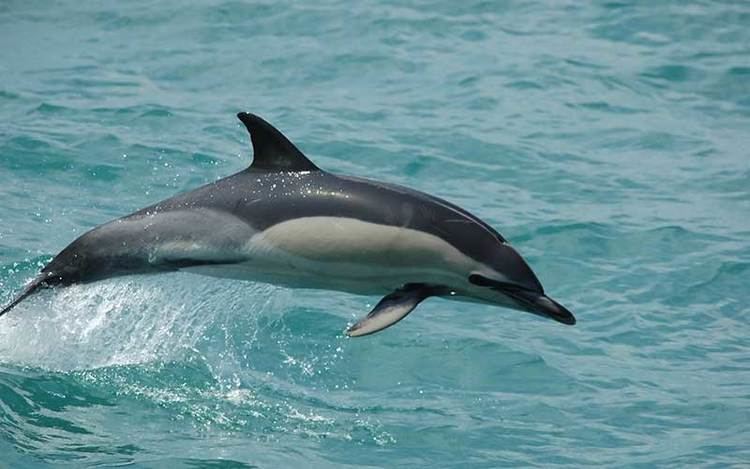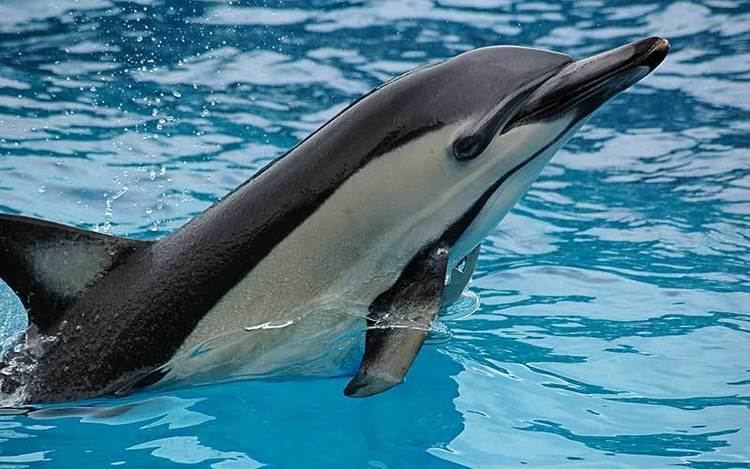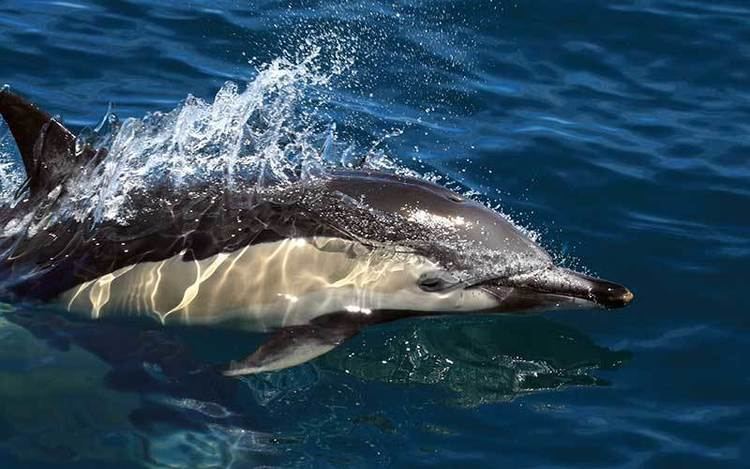Order Artiodactyla Family Delphinidae Rank Genus | Phylum Chordata Scientific name Delphinus | |
 | ||
Mass Short-beaked common dolphin: 100 – 140 kg Length Short-beaked common dolphin: 1.5 – 2.4 m Gestation period Short-beaked common dolphin: 10 – 11 months Lower classifications Short‑beaked common dolphin, Long‑beaked common dolphin | ||
Long beaked common dolphin stampede
The common dolphin is the name given to two species (and possibly a third) of dolphin making up the genus Delphinus.
Contents
- Long beaked common dolphin stampede
- Common dolphin species identification
- Physical characteristics
- Differentiating species
- Natural history
- Conservation
- Captivity
- References

Prior to the mid-1990s, most taxonomists only recognised one species in this genus, the common dolphin Delphinus delphis. Modern cetologists usually recognise two species — the short-beaked common dolphin, which retains the systematic name Delphinus delphis, and the long-beaked common dolphin Delphinus capensis.
The common dolphin is not the dolphin of popular imagination despite its name; that distinction belongs to the bottlenose dolphin (genus Tursiops) due to its widespread use in marine parks and its appearance in the television series Flipper. However, this dolphin was the most frequently represented in the art and literature of ancient Greece and Rome.

Common dolphin species identification
Physical characteristics

Both common dolphin species are medium-sized; adults range between 1.9 and 2.5 m (6.2 and 8.2 ft) long, and can weigh between 80–235 kg (176–518 lb), although the range between 80–150 kg (180–330 lb) is more common. Males are generally longer and heavier. The color pattern on the body is unusual. The back is dark and the belly is white, while on each side is an hourglass pattern colored light grey, yellow, or gold in front and dirty grey in back. They have long, thin rostra with up to 50–60 small, sharp, interlocking teeth on each side of each jaw.
Differentiating species

Despite the historic practice of lumping the entire Delphinus genus into a single species, these widely distributed dolphins exhibit a wide variety of sizes, shapes and colors. Indeed, over the past few decades, over 20 distinct species in the genus have been proposed. Scientists in California in the 1960s concluded there were two species — the long-beaked and short-beaked. This analysis was essentially confirmed by a more in-depth genetic study in the 1990s. This study also suggested a third species (D. tropicalis, common name usually Arabian common dolphin), characterized by an extremely long and thin beak and found in the Red Sea and Indian Ocean, might be distinguished from the long-beaked species. The current standard taxonomic works recognize this as just a regional variety. D. tropicalis is a subspecies of D. capensis.
Natural history

Common dolphins live in both warm-temperate and tropical waters ranging from 40–60°N to 50°S. Long-beaked common dolphins mostly inhabit shallow, warm coastal water. Short-beaked common dolphins are common "along shelf edges and in areas with sharp bottom relief such as seamounts and escarpments". Common dolphin have a varied diet consisting of many species of fish and squid. This includes both mesopelagic species and epipelagic schooling species. They have been recorded to make dives up to 200 metres (660 ft) deep.
Common dolphins can live in aggregations of hundreds or even thousands of dolphins. They sometimes associate with other dolphin species, such as pilot whales. They have also been observed bow riding on baleen whales, and they also bow ride on boats. They are fast swimmers (up to 60 km/h), and breaching behavior and aerial acrobatics are common with this species. They are also known to display altruistic behaviors to support injured members.
The short-beaked common dolphin has a gestation period of 10 to 11 months. The newborn calf has a length of 70 to 100 centimetres (2.3 to 3.3 ft) and weighs about 10 kilograms (22 lb). For the Black Sea population, weaning occurs at between five and six months, but occurs later (up to about 19 months) in other areas. Typical interbirth interval ranges from one year for the Black Sea population to three years for eastern Pacific Ocean populations. Age of sexual maturity also varies by location, but can range between two and seven years for females and three and 12 years for males. No evidence exists of any major reproductive differences between the two species. In captivity, the long-beaked common dolphin has hybridized with the common bottlenose dolphin (Tursiops truncatus). One of the hybrids has been bred back to a bottlenose dolphin, demonstrating such hybrids are fertile.
Conservation
Common dolphins face a mixture of threats due to human influence. Moderate levels of metal pollutants, which are thought to negatively impact dolphin health, have been measured in some populations. Populations have been hunted off the coast of Peru for use as food and shark bait. In most other areas, the dolphins have not been hunted directly. Several thousand individuals have been caught in industrial trawler nets throughout their range. Common dolphins were abundant in the western Mediterranean Sea until the 1960s but occurrences there have tailed off rapidly. The reasons are not well understood, but are believed to be due to extensive human activity in the area. In the US, they are a protected species and sometimes are caught by accident in some trawler nets as bycatch, though despite this they are still quite common throughout their range. Despite these potential threats, the short-beaked common dolphin is considered to be Least Concern by the IUCN Red List, and the long-beaked common dolphin is listed as Data Deficient.
The short-beaked common dolphin Delphinus delphis is listed globally on Appendix II of the Convention on the Conservation of Migratory Species of Wild Animals (CMS). As amended by the Conference of the Parties in 1985, 1988, 1991, 1994, 1997, 1999, 2002, 2005 and 2008. Effective: 5 March 2009 of the Convention on the Conservation of Migratory Species of Wild Animals (CMS) as it has an unfavourable conservation status or would benefit significantly from international co-operation organised by tailored agreements. The Mediterranean population of the short-beaked common dolphin is also listed on Appendix I, as this population has been categorized as being in danger of extinction throughout all or a significant proportion of their range and CMS Parties strive towards strictly protecting these animals, conserving or restoring the places where they live, mitigating obstacles to migration and controlling other factors that might endanger them. In addition, the species is also covered by the Agreement on the Conservation of Small Cetaceans of the Baltic, North East Atlantic, Irish and North Seas (ASCOBANS) and the Agreement on the Conservation of Cetaceans in the Black Sea, Mediterranean Sea and Contiguous Atlantic Area (ACCOBAMS).
Captivity
Common dolphins are not common in captivity. But on at least three occasions, a beached common dolphin in California was nursed back to health at SeaWorld San Diego, but deemed unfit to release back to the ocean. These common dolphins remained at SeaWorld with the bottlenose dolphin exhibit. On one occasion, a male common dolphin managed to impregnate one of the female bottlenose dolphins in the exhibit, leading to four hybrid births. One of the resulting common dolphin/bottlenose dolphin hybrids remained at SeaWorld, San Diego (alternately under the name Cindy or Bullet) while the other was kept at Discovery Cove. They also participate in shows with bottlenose dolphin and pilot whale at Sea World.
Other than at SeaWorld, at least 90 common dolphins are known to have been captured from the wild and kept in captivity. Captured common dolphins are said to be difficult to keep in captivity.
